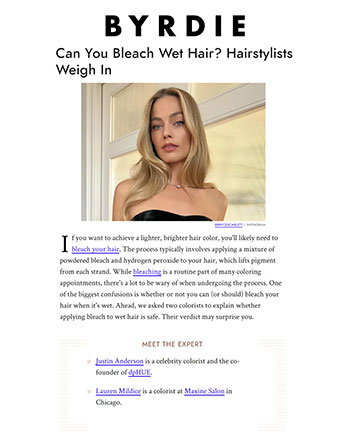Byrdie April 22, 2024
BYRDIE
Hair
Can You Bleach Wet Hair? Hairstylists Weigh In
If you want to achieve a lighter, brighter hair color, you'll likely need to bleach your hair. The process typically involves applying a mixture of powdered bleach and hydrogen peroxide to your hair, which lifts pigment from each strand. While bleaching is a routine part of many coloring appointments, there's a lot to be wary of when undergoing the process. One of the biggest confusions is whether or not you can (or should) bleach your hair when it's wet. Ahead, we asked two colorists to explain whether applying bleach to wet hair is safe. Their verdict may surprise you.
MEET THE EXPERT
Justin Anderson is a celebrity colorist and the co-founder of dpHUE.
Lauren Mildice is a colorist at Maxine Salon in Chicago.
Can You Bleach Wet Hair?
The short answer is yes. "When you don't want the hair to lift as much, bleaching [your hair while it is damp] can help you make a subtle [color] change to your hair," according to Anderson. This is because water helps to dilute the bleaching agent.
According to our experts, bleaching wet hair also results in faster processing. "If you towel dry your hair and it is still damp, the bleach will act stronger since the hair cuticle is already open when it is wet."
Aside from an all-over application on damp hair, additional wet bleach methods include bleach bathing (mixing bleach with shampoo) and express balayage (applying bleach to the top of the hair and hairline). In general, the amount of time you should leave bleach on wet hair depends on your hair type, texture, and how bright you want your color. Anderson suggests waiting 10 to 30 minutes (leaving it on longer than this can lead to severe hair damage).
The Difference Between Bleaching Dry vs Wet Hair
Bleaching wet hair creates a diffused, soft effect, and the resulting color covers a larger surface area. Whereas, bleaching dry hair allows you to achieve more targeted results. As Anderson explains, "When your hair is dry, your colorist can isolate finer pieces, which is great for highlights, creating contrast, and color corrections."
Applying bleach to dry hair lets the lightening agent penetrate further into your hair cuticle and cortex to dissolve melanin, leading to a more vibrant and bold result. "Although this may take longer, bleaching dry hair allows you to use various techniques and placement strategies that damp hair does not," Mildice adds.
Should You Bleach Wet Hair At Home?
If you're considering bleaching your hair, Mildice and Anderson suggest leaving the heavy lifting to a professional colorist. Whether dealing with wet or dry hair, bleaching can easily and quickly damage your hair if done incorrectly. "If you misapply the bleach to wet, damp, or dry hair, it may marbleize and end up creating a bigger mess than if you were to go to the salon to see a trained professional," Mildice says. Both experts say that some over-the-counter bleaching products could trigger a chemical reaction and potentially fry your hair.
The Final Takeaway
Bleaching wet hair is a worthwhile approach if you're aiming to achieve a subtly lightened look. However, both experts suggest leaving the bleaching process to the pros, as the chemical solution is incredibly potent and can severely damage your hair if applied incorrectly or left on too long. And, of course, since bleaching can be harsh on your hair, it's important to adhere to a proper aftercare routine. You'll want to limit heat styling, use shampoos and conditioners for color-treated hair, and invest in deep conditioning treatments.

